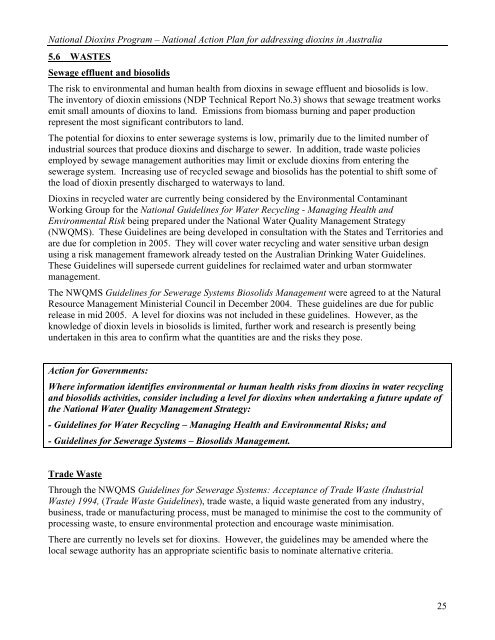National Action Plan for Addressing Dioxins in Australia
National Action Plan for Addressing Dioxins in Australia
National Action Plan for Addressing Dioxins in Australia
- No tags were found...
You also want an ePaper? Increase the reach of your titles
YUMPU automatically turns print PDFs into web optimized ePapers that Google loves.
<strong>National</strong> <strong>Diox<strong>in</strong>s</strong> Program – <strong>National</strong> <strong>Action</strong> <strong>Plan</strong> <strong>for</strong> address<strong>in</strong>g diox<strong>in</strong>s <strong>in</strong> <strong>Australia</strong>5.6 WASTESSewage effluent and biosolidsThe risk to environmental and human health from diox<strong>in</strong>s <strong>in</strong> sewage effluent and biosolids is low.The <strong>in</strong>ventory of diox<strong>in</strong> emissions (NDP Technical Report No.3) shows that sewage treatment worksemit small amounts of diox<strong>in</strong>s to land. Emissions from biomass burn<strong>in</strong>g and paper productionrepresent the most significant contributors to land.The potential <strong>for</strong> diox<strong>in</strong>s to enter sewerage systems is low, primarily due to the limited number of<strong>in</strong>dustrial sources that produce diox<strong>in</strong>s and discharge to sewer. In addition, trade waste policiesemployed by sewage management authorities may limit or exclude diox<strong>in</strong>s from enter<strong>in</strong>g thesewerage system. Increas<strong>in</strong>g use of recycled sewage and biosolids has the potential to shift some ofthe load of diox<strong>in</strong> presently discharged to waterways to land.<strong>Diox<strong>in</strong>s</strong> <strong>in</strong> recycled water are currently be<strong>in</strong>g considered by the Environmental Contam<strong>in</strong>antWork<strong>in</strong>g Group <strong>for</strong> the <strong>National</strong> Guidel<strong>in</strong>es <strong>for</strong> Water Recycl<strong>in</strong>g - Manag<strong>in</strong>g Health andEnvironmental Risk be<strong>in</strong>g prepared under the <strong>National</strong> Water Quality Management Strategy(NWQMS). These Guidel<strong>in</strong>es are be<strong>in</strong>g developed <strong>in</strong> consultation with the States and Territories andare due <strong>for</strong> completion <strong>in</strong> 2005. They will cover water recycl<strong>in</strong>g and water sensitive urban designus<strong>in</strong>g a risk management framework already tested on the <strong>Australia</strong>n Dr<strong>in</strong>k<strong>in</strong>g Water Guidel<strong>in</strong>es.These Guidel<strong>in</strong>es will supersede current guidel<strong>in</strong>es <strong>for</strong> reclaimed water and urban stormwatermanagement.The NWQMS Guidel<strong>in</strong>es <strong>for</strong> Sewerage Systems Biosolids Management were agreed to at the NaturalResource Management M<strong>in</strong>isterial Council <strong>in</strong> December 2004. These guidel<strong>in</strong>es are due <strong>for</strong> publicrelease <strong>in</strong> mid 2005. A level <strong>for</strong> diox<strong>in</strong>s was not <strong>in</strong>cluded <strong>in</strong> these guidel<strong>in</strong>es. However, as theknowledge of diox<strong>in</strong> levels <strong>in</strong> biosolids is limited, further work and research is presently be<strong>in</strong>gundertaken <strong>in</strong> this area to confirm what the quantities are and the risks they pose.<strong>Action</strong> <strong>for</strong> Governments:Where <strong>in</strong><strong>for</strong>mation identifies environmental or human health risks from diox<strong>in</strong>s <strong>in</strong> water recycl<strong>in</strong>gand biosolids activities, consider <strong>in</strong>clud<strong>in</strong>g a level <strong>for</strong> diox<strong>in</strong>s when undertak<strong>in</strong>g a future update ofthe <strong>National</strong> Water Quality Management Strategy:- Guidel<strong>in</strong>es <strong>for</strong> Water Recycl<strong>in</strong>g – Manag<strong>in</strong>g Health and Environmental Risks; and- Guidel<strong>in</strong>es <strong>for</strong> Sewerage Systems – Biosolids Management.Trade WasteThrough the NWQMS Guidel<strong>in</strong>es <strong>for</strong> Sewerage Systems: Acceptance of Trade Waste (IndustrialWaste) 1994, (Trade Waste Guidel<strong>in</strong>es), trade waste, a liquid waste generated from any <strong>in</strong>dustry,bus<strong>in</strong>ess, trade or manufactur<strong>in</strong>g process, must be managed to m<strong>in</strong>imise the cost to the community ofprocess<strong>in</strong>g waste, to ensure environmental protection and encourage waste m<strong>in</strong>imisation.There are currently no levels set <strong>for</strong> diox<strong>in</strong>s. However, the guidel<strong>in</strong>es may be amended where thelocal sewage authority has an appropriate scientific basis to nom<strong>in</strong>ate alternative criteria.25
















